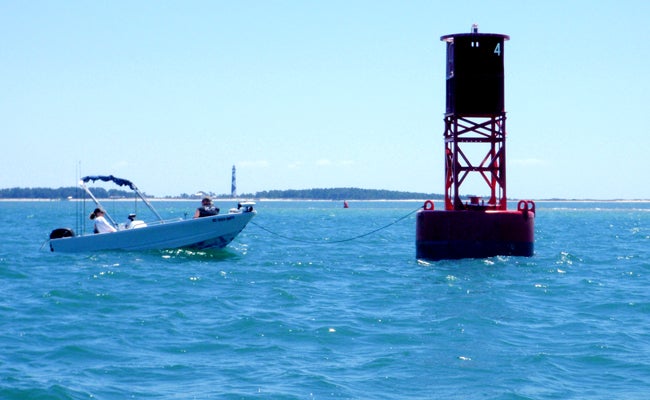Not yet time for big bluefish at Cape Lookout
Published 12:13 pm Saturday, April 25, 2015

FRED BONNER | CONTRIBUTED
REELIN’ THEM IN: There’s no such thing as a bad day out fishing. With great expectations of finding the big, early, bluefish, feeding in and around Cape Lookout, anglers find that catching a few smaller fish while peacefully rocking in the waves in Barden Inlet beats mowing the grass at home.
It’s been many years since fishery biologist Jim Brown of the N.C. Division of Marine Fisheries introduced me to fishing for bluefish at Cape Lookout during the month of May. Brown felt that these fish were migrating northward along the N.C. Coast and simply took a few days off from their annual migration to slip into the sounds behind Cape Lookout to gorge themselves on menhaden they found in these protected waters.
A few savvy anglers seem to look forward to fishing for these bluefish each May. After the doldrums of winter fishing, some just try to get the jump on these early blues and strike out for Cape Lookout during late April. It didn’t work this year.
Reports from Captain Noah Lynch, who keeps his boat appropriately named the “Noah’s Ark” at Hacker’s Island, had told us that they’d been “wearing the smaller bluefish out” in Core Sound behind the Cape, but the big blues just hadn’t started to show yet.”
We should have listened to him. The long days of being cooped-up in the house and wishing for the better saltwater fishing to begin took precedence over common sense, and we trailered the boat to Harker’s Island to see for ourselves if the big blues might have been there.
In past years, we’d caught these early blues behind Cape Lookout by casting top water lures on relatively light spinning and casting gear. Bluefish are notoriously voracious feeders and the sight of what appears to them as frantic baitfish thrashing across the surface often spurs these hungry fish into an explosive strike. Even a two-pound bluefish on light tackle puts up a good fight.
On occasion we’ve even tried wading the flats behind the Cape and casting streamer (flies) at these fish, ones we could easily see swimming past us in the clear water. Some Tar Heel anglers have referred to this type of fly-fishing as being our answer to bonefish fishing in the Bahamas.
It seems that this fabulous (but short lived) early fishery needs a few more warm days until it develops into its full potential.
We observed a few boats fishing the flats behind the Cape, so we followed their lead and tried drifting with the incoming tide across the shallows and casting a variety of plugs. We caught nothing.
The few boats that were fishing at Cape Lookout were leaving the more protected waters in the sounds and trying their luck by bottom fishing just inside “the hook” of the Cape. A bottlenose dolphin was patrolling the bight of the hook looking for something to eat and obviously the fishermen thought that the “porpoises” were onto something.
It was just inside the Barden Inlet that the only two fish of the day for our boat were caught. One bluefish was about eight inches long and the other was about 12 inches long. Even a bluefish as small as the eight incher lived up to its reputation of being a fighter though. As I attempted to remove the treble hook from the fish’s head, it used its notoriously sharp teeth to take a bite out of my finger.
Small passenger ferries from the Cape Lookout National Seashore (AKA Park Service) were constantly taking sightseers over the Shackelford and Core Banks to walk the nearly deserted beaches, observe the wild horses and visit the famous Cape Lookout lighthouse with its diamond shaped black and white markings. It’s probably going to be the only time this year that the tourists will outnumber the fishermen in this area.
A few more warm days will hopefully see the larger bluefish begin to show up in the area. They will not be concentrated in this area for very long and a lot of our anglers will be hoping that their fishing trip to the Cape Lookout area will coincide with the bluefish’s annual stopover at Cape Lookout. If the anglers are successful, they may experience one of our area’s really outstanding sport fisheries.





